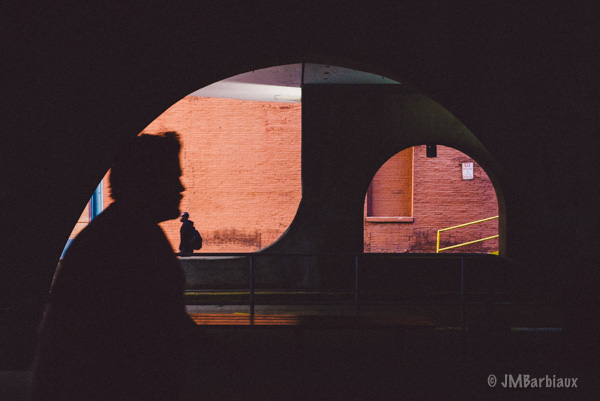If you type the word silhouette into Instagram under search (tags) you’ll come up with roughly 6.6 million images (and growing). Granted, that is not as many as if you type in the word babe (10.9 mil and growing) but guys are gross, amiright (fist bump). The point is, silhouette photography is incredibly popular and not very difficult to master. However, there is a difference between having a silhouette in your photograph and creating a beautiful silhouette photograph.
 You can create a silhouette almost anywhere, with just about any subject matter.
You can create a silhouette almost anywhere, with just about any subject matter.
Silhouettes are created by photographing your subject with it/them between you and a bright light source like the sun or even car headlights. The light source does not have to be as bright as the giant ball of fiery gas in the sky, just bright enough to allow you to meter for the light source and render your subject a dark silhouette. In fact, you probably inadvertently have created silhouettes each time you photograph the sunset. Many times, when photographing the sunset or sunrises, photographers meter off of the brightest area in order to keep the highlights from clipping and retain the beautiful colors of the sky. By metering for the sky you’re clipping the shadows, put your subject between you and the sky and you’ve got yourself a silhouette.
Okay, now that we’ve got the easy part out of the way lets talk about how to make the most of your silhouette photography. I mentioned above that it’s fairly easy to create a silhouette but it can be more challenging to create silhouettes that stand out, dare I say “artistic” silhouettes. One of the biggest reasons for this is that the photographer focuses all their attention on the silhouette without much concern for the background or surroundings of their subject which can have a huge impact on whether the photograph is successful or not.
Mind Your Background
If your main subject is a silhouette, a dark outline of whatever it is you’re photographing, there is very little detail in the image other than the background. This renders the background almost equally as important as the subject, the background needs to act as a composition builder, there is no room for failure here.
When you see silhouette photography like the image above it is fairly easy to dismiss the series of events captured here as happenstance or luck. But what you can see below is that this was number 4 of 18 different shots. Though the shutter speed was a mere 1/90th of a second, the time spent waiting for all of the pieces to fall into place took roughly 20 minutes (the kids swinging probably thought I was some kind of weirdo).
One of the easiest ways to improve your silhouette photography is to mind your backgrounds. This doesn’t mean you must have multiple layers like in the image above but it does mean that your background can not detract from your subject matter. Spend more time making sure your background adds strength to the image rather than weakens it by distracting from your main subject. I’ve seen plenty of beautiful silhouettes that just don’t work because you can see some eyesore in the background that demands viewers attention away from the main subject.
Think Outside Of The Box
Remember when I said you don’t need to use the sun to create a silhouette? Would you believe me If I told you that you don’t even need direct light? The image below was taken with the subject between me and a wall bouncing soft light (that was reflected from a buildings windows) towards me. Shooting from under the building, which was darker than the wall, allowed me to meter for the wall which made the shutter speed fast enough that the dark areas didn’t have enough light to register much data in the shadows… In short, it allowed me to created a silhouette of anybody walking between me and the wall so long as they were in the shadow area as well (notice the man next to the wall is not actually a silhouette because light is being reflected onto him as well).
Keep your eyes open for subtle changes in light like this as well. Always remember that you don’t need blindingly bright light to create a silhouette and you’re sure to capture some awesome silhouettes in unique areas.
Color Or Black And White
Now, this is purely a subjective point of view but I believe color photography makes for the best silhouette images (there is an exception to every rule of course). I think that the juxtaposition between color and your subject (a silhouette is a lack of color, right?) adds depth and interest to most photographs.
Next time you’re out and about with your camera keep your eye out for silhouette opportunities where you wouldn’t have looked before. Mind your background and make sure there is nothing to distract viewers from your main subject. Try shooting in color, if you have not done so, to add depth and interest to your silhouettes.
Feel free to leave your thoughts in the comments section below.








